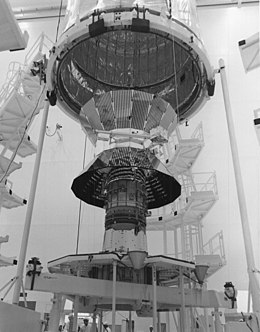
Back هيليوس (مسبار فضائي) Arabic Helios (sondes espaciales) AST Хелиос (космически апарат) Bulgarian Program Helios Czech Helios (Raumsonde) German Helios (sondas espaciales) Spanish هلیوس (فضاپیما) Persian Helios (avaruusluotain) Finnish Helios (sonde spatiale) French Helios (spásárthach) Irish
This article includes a list of general references, but it lacks sufficient corresponding inline citations. (August 2022) |
 Prototype of the Helios spacecraft | |
| Mission type | Solar observation |
|---|---|
| Operator | |
| COSPAR ID | Helios-A: 1974-097A Helios-B: 1976-003A |
| SATCAT no. | Helios-A: 7567 Helios-B: 8582 |
| Website | Helios-A: [1] Helios-B: [2] |
| Mission duration | Helios-A: 10 years, 1 month, 2 days Helios-B: 3 years, 5 months, 2 days |
| Spacecraft properties | |
| Manufacturer | MBB |
| Launch mass | Helios-A: 371.2 kg (818 lb) Helios-B: 374 kg (825 lb) |
| Power | 270 watts (solar array) |
| Start of mission | |
| Launch date | Helios-A: December 10, 1974, 07:11:01 UTC[1] Helios-B: January 15, 1976, 05:34:00 UTC[2] |
| Rocket | Titan IIIE / Centaur |
| Launch site | Cape Canaveral SLC-41 |
| Entered service | Helios-A: January 16, 1975 Helios-B: July 21, 1976 |
| End of mission | |
| Deactivated | Helios-A: February 18, 1985 Helios-B: December 23, 1979 |
| Last contact | Helios-A: February 10, 1986 Helios-B: March 3, 1980 |
| Orbital parameters | |
| Reference system | Heliocentric |
| Eccentricity | Helios-A: 0.5218 Helios-B: 0.5456 |
| Perihelion altitude | Helios-A: 0.31 AU Helios-B: 0.29 AU |
| Aphelion altitude | Helios-A: 0.99 AU Helios-B: 0.98 AU |
| Inclination | Helios-A: 0.02° Helios-B: 0° |
| Period | Helios-A: 190.15 days Helios-B: 185.6 days |
| Epoch | Helios-A: January 15, 1975, 19:00 UTC[1] Helios-B: July 20, 1976, 20:00 UTC[2] |
Helios-A and Helios-B (after launch renamed Helios 1 and Helios 2) are a pair of probes that were launched into heliocentric orbit to study solar processes. As a joint venture between German Aerospace Center (DLR) and NASA, the probes were launched from Cape Canaveral Air Force Station, Florida, on December 10, 1974, and January 15, 1976, respectively.
The Helios project set a maximum speed record for spacecraft of 252,792 km/h (157,078 mph; 70,220 m/s).[3] Helios-B performed the closest flyby of the Sun of any spacecraft until that time. The probes are no longer functional, but as of 2024 remain in elliptical orbits around the Sun.
- ^ a b Cite error: The named reference
orbit3was invoked but never defined (see the help page). - ^ a b "Helios-B – Trajectory Details". National Space Science Data Center. NASA. Retrieved July 12, 2017.
- ^ Wilkinson, John (2012), New Eyes on the Sun: A Guide to Satellite Images and Amateur Observation, Astronomers' Universe Series, Springer, p. 37, Bibcode:2012nesg.book.....W, ISBN 978-3-642-22838-4
© MMXXIII Rich X Search. We shall prevail. All rights reserved. Rich X Search